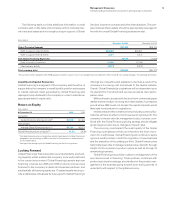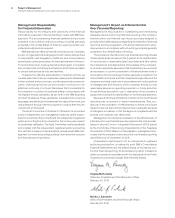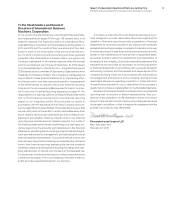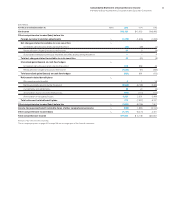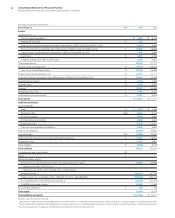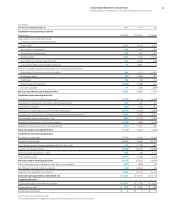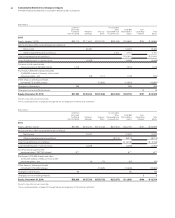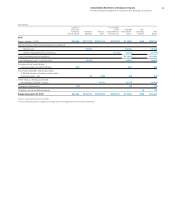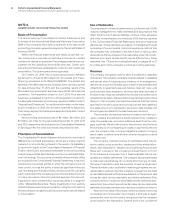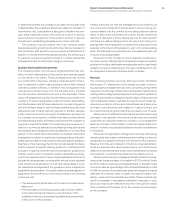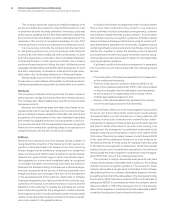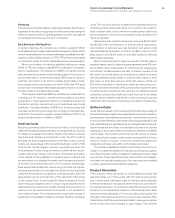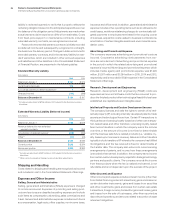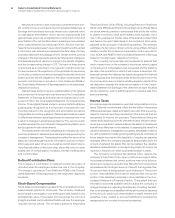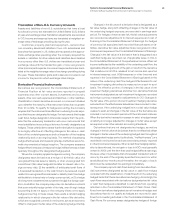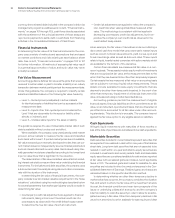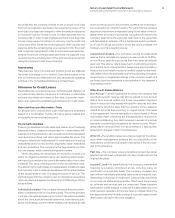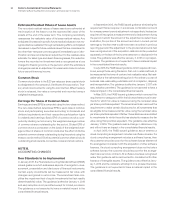IBM 2015 Annual Report Download - page 85
Download and view the complete annual report
Please find page 85 of the 2015 IBM annual report below. You can navigate through the pages in the report by either clicking on the pages listed below, or by using the keyword search tool below to find specific information within the annual report.Notes to Consolidated Financial Statements
International Business Machines Corporation and Subsidiary Companies
83
to determine whether the company is an agent or principal, most
notably whether the company is the primary obligor to the client, or
has inventory risk. Consideration is also given to whether the com-
pany adds meaningful value to the vendor’s product or service,
was involved in the selection of the vendor’s product or service,
has latitude in establishing the sales price or has credit risk.
The company reports revenue net of any revenue-based
taxes assessed by governmental authorities that are imposed on
and concurrent with specific revenue-producing transactions. In
addition to the aforementioned general policies, the following are
the specific revenue recognition policies for multiple-deliverable
arrangements and for each major category of revenue.
Multiple-Deliverable Arrangements
The company enters into revenue arrangements that may con-
sist of multiple deliverables of its products and services based
on the needs of its clients. These arrangements may include
any combination of services, software, hardware and/or financ-
ing. For example, a client may purchase a server that includes
operating system software. In addition, the arrangement may
include post-contract support for the software and a contract
for post-warranty maintenance service for the hardware. These
types of arrangements can also include financing provided by the
company. These arrangements consist of multiple deliverables,
with the hardware and software delivered in one reporting period
and the software support and hardware maintenance services
delivered across multiple reporting periods. In another example,
a client may outsource the running of its datacenter operations to
the company on a long-term, multiple-year basis and periodically
purchase servers and/or software products from the company to
upgrade or expand its facility. The outsourcing services are pro-
vided on a continuous basis across multiple reporting periods and
the hardware and software products are delivered in one reporting
period. To the extent that a deliverable in a multiple-deliverable
arrangement is subject to specific accounting guidance that deliv-
erable is accounted for in accordance with such specific guidance.
Examples of such arrangements may include leased hardware
which is subject to specific leasing guidance or software which
is subject to specific software revenue recognition guidance on
whether and/or how to separate multiple-deliverable arrange-
ments into separate units of accounting (separability) and how to
allocate the arrangement consideration among those separate
units of accounting (allocation). For all other deliverables in multi-
ple-deliverable arrangements, the guidance below is applied for
separability and allocation. A multiple-deliverable arrangement is
separated into more than one unit of accounting if the following
criteria are met:
• The delivered item(s) has value to the client on a stand-alone
basis; and
• If the arrangement includes a general right of return relative
to the delivered item(s), delivery or performance of the
undelivered item(s) is considered probable and substantially
in the control of the company.
If these criteria are not met, the arrangement is accounted for as
one unit of accounting which would result in revenue being rec-
ognized ratably over the contract term or being deferred until the
earlier of when such criteria are met or when the last undelivered
element is delivered. If these criteria are met for each element
and there is a relative selling price for all units of accounting in an
arrangement, the arrangement consideration is allocated to the
separate units of accounting based on each unit’s relative selling
price. The following revenue policies are then applied to each unit
of accounting, as applicable.
Revenue from the company’s cloud, analytics, mobile, secu-
rity, and cognitive offerings follow the specific revenue recognition
policies for multiple-deliverable arrangements and for each major
category of revenue depending on the type of offering which can
be comprised of services, hardware and/or software.
Services
The company’s primary services offerings include information
technology (IT) datacenter and business process outsourc-
ing, application management services, consulting and systems
integration, technology infrastructure and system maintenance,
hosting and the design and development of complex IT systems to
a client’s specifications (design and build). Many of these services
can be delivered entirely or partially through the cloud. These ser-
vices are provided on a time-and-material basis, as a fixed-price
contract or as a fixed-price per measure of output contract and
the contract terms range from less than one year to over 10years.
Revenue from IT datacenter and business process outsourcing
contracts is recognized in the period the services are provided
using either an objective measure of output or on a straight-line
basis over the term of the contract. Under the output method, the
amount of revenue recognized is based on the services delivered
in the period.
Revenue from application management services, technology
infrastructure and system maintenance and hosting contracts is
recognized on a straight-line basis over the terms of the contracts.
Revenue from time-and-material contracts is recognized as labor
hours are delivered and direct expenses are incurred. Revenue
related to extended warranty and product maintenance contracts
is recognized on a straight-line basis over the delivery period.
Revenue from fixed-price design and build contracts is recog-
nized under the percentage-of-completion (POC) method. Under
the POC method, revenue is recognized based on the labor costs
incurred to date as a percentage of the total estimated labor costs
to fulfill the contract. If circumstances arise that change the original
estimates of revenues, costs, or extent of progress toward com-
pletion, revisions to the estimates are made. These revisions may
result in increases or decreases in estimated revenues or costs,
and such revisions are reflected in income in the period in which
the circumstances that gave rise to the revision become known
by the company.


